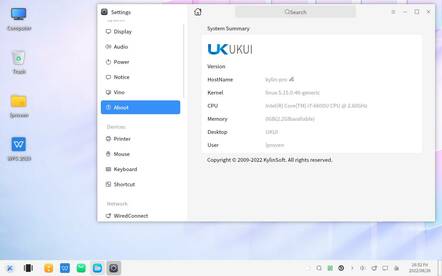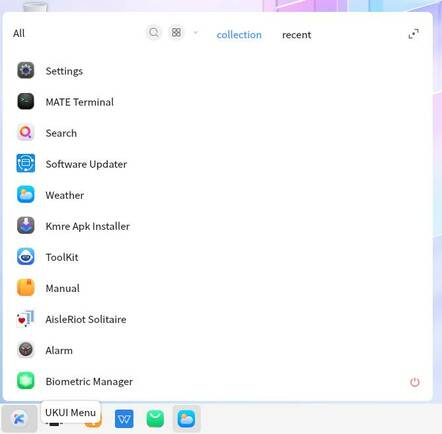This article is more than 1 year old
Kylin: The multiple semi-official Chinese versions of Ubuntu
Investigating the world of Chinese Linux
Ubuntu's special distro for the Chinese market has a widening edge over the company's more conventional flavors.
Ubuntu 22.04.1 appeared earlier this month, and along with the other flavors of Ubuntu, that means a new release of Ubuntu Kylin too. We looked at its resource usage alongside two other desktops, but Ubuntu Kylin is more than just another desktop on top of the same base OS.
It has become a joke that the year of the Linux desktop never comes and never will – regardless of the fact that one desktop Linux distro is used by many millions of presumably happy purchasers and is still selling strongly.
In the Western Linux world, it's servers that make money, which is why most Linux R&D investment goes into server-side stuff, such as containers and hypervisors. Sometimes, server tech can be repurposed or adapted for use on the desktop: for instance, sandboxed desktop app-packaging formats, immutable distros with read-only root filesystems, and of course the dreaded systemd.
This is why The Reg FOSS desk takes a keen interest in Chinese distributions: in this segment, there's active new investment in desktops. Although the Chinese government shut down its official Linux flavor in 2014, the 3-5-2 program to reduce dependencies on foreign operating systems is still underway. This means a big opportunity for Chinese businesses, and real effort is going into desktop software tailored for Chinese users. Given the size of the Chinese domestic market, we suspect that significant elements of the future desktop Linux OSes may come from the direction of the rising sun.
What it looks like from the outside
In the English-speaking world, the most visible results are Linux Deepin and Ubuntu Kylin. The relatively well-known Linux Deepin is an offshoot of UnionTech's UOS. Its Deepin Desktop Environment, DDE for short, is available on several other distros, and there was even an Ubuntu remix, Ubuntu-DDE, but sadly this hasn't been updated for Ubuntu 22.04.
Alongside DDE, the other Sino-centric desktop environment is the Ubuntu Kylin User Interface, or UKUI. UKUI started out as a fork of the MATE desktop (itself an Argentinian fork of GNOME 2). Up to version 2, UKUI was, like MATE, based on Gtk. While MATE itself migrated to Gtk3, the developers of UKUI rewrote version 3 using Qt instead – mirroring the move of LXDE's "PCMan" in creating LXQt.
As its name suggests, UKUI came out of the Ubuntu Kylin project, but other distros use it too. On the project's community page it also lists Debian, Arch Linux and openEuler.
In case the last one isn't familiar, it's the free version of Huawei's enterprise distro EulerOS, which has the unique distinction of being the only Linux distribution currently featured on the Open Group's list of UNIX® Certified Products.
Chinese server vendor Inspur also has its own distro, K-UX, which was formerly certified, but has since disappeared from the company's website. Both are (or were) RHEL rebuilds and default to RHEL's GNOME 3 desktop.
openKylin
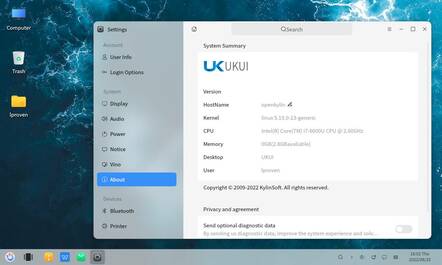
The only easy way to distinguish openKylin from Ubuntu Kylin is a slightly different logo on the start menu – other than that, they're very similar indeed
Strangely missing from the UKUI site is its Chinese progenitor KylinOS, the official national distribution. The Register looked at the history of KylinOS recently when the project launched a free distro, openKylin (Chinese language link).
Out of curiosity, the intrepid Reg FOSS desk downloaded it and gave it a try. Although this vulture's ability to read Zhōngwén is extremely limited, it's not completely nonexistent, and we managed to boot the ISO and log in (the username is openkylin with no password). By disabling VirtualBox's 3D graphics acceleration, we got to the desktop. After some tentative exploration, we found the installation program, and in there is an option to use English. We did that, and it then installed without a hitch.
OpenKylin has its own installation program. An interesting foible is that this asks you to provide a username for the new system, rather than asking for a full name and then suggest a username based on abbreviating it. This makes sense for a language that doesn't use an alphabet as such: for example, how would you abbreviate "孫中山"? It also requires at least eight-character passwords. Similarly, only usernames are shown on the login screen.
If openKylin is an accurate indicator, then rather than Ubuntu Kylin being based on Ubuntu with the desktop from KylinOS, it's really the other way round: openKylin is based on Ubuntu. Specifically, openKylin 0.7 uses kernel 5.15 built with GCC 9.3, so we suspect it is based on Ubuntu 20.04 with the HWE kernel. The first and most visible difference between openKylin and Ubuntu Kylin is that openKylin's login screen gives you the choice of X.org or Wayland.
The two different editions of Ubuntu Kylin
We suspect that users from the international community, if they can't read Chinese, will be more interested in Ubuntu's flavor of Kylin.
Interestingly, there seem to be two different editions of Ubuntu Kylin. If you visit ubuntukylin.com and click the letters "EN" at top right, you get the English-language homepage. This links to a downloads page with two editions: version 22.04 for X86, and version 20.04 for RISC-V. There's no 22.04.1 download, at least yet, and "X86" denotes the 64-bit version. The current version is ubuntukylin-22.04-pro-amd64.iso.
In an interesting wrinkle, though, if you go via Ubuntu's releases page and pick Ubuntu Kylin, you get a different ISO, called ubuntukylin-22.04.1-desktop-amd64.iso.
So what's the difference? To find out, we tried both. Both are based on Ubuntu 22.04, but they're not the same distro. We decided to use the names of the ISO files to distinguish them: the international Ubuntu Kylin, and the Chinese Ubuntu Kylin Pro.
Ubuntu Kylin Pro
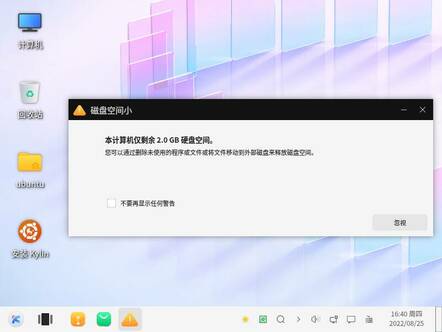
Kylin Pro starts up in Chinese, but don't panic. Just click the only button there is, then the last desktop icon
Ubuntu Kylin Pro has two notable similarities to openKylin. To boot it in VirtualBox, 3D acceleration must be turned off or the desktop won't appear. Also, Kylin Pro starts up in Chinese. However, in the installation program – which is the last icon on the desktop – you can pick English, and then the whole program switches alphabets. That is the only choice of localization you get: US English or Chinese, nothing else.
Like openKylin, the Kylin Pro installation program wants you to invent a username; there's no field to enter a full name. It also requires at least eight characters for the password, and the login screen shows only usernames not full names. However, Kylin Pro's login screen doesn't offer Wayland or any choice of desktop at all.
The installation program demands a separate /boot partition and won't install without one. It also wants 128GB of space, we suspect for a complex partition layout, as the Reg FOSS desk described for Deepin 20.5. To coax it onto a VM with a mere 20GB of space, we had to do a custom install, create a single root partition and point it at that. After a reboot, it accepted it and proceeded.
Like the download itself, installation is quite slow, because Kylin Pro fetches packages from Chinese download servers. Once installed, the standard method for choosing a local mirror repository worked fine, but due to missing security keys, Kylin Pro refused to install any packages from them.
- Deepin prepares to leave Debian base and move to fully independent distro
- Weighing the less mainstream Ubuntu remixes: Including China's Kylin
- How a botched kernel patch broke Ubuntu – and why it may happen again
- China rallies support for Kylin Linux in war on Windows
Once installed, you get a fully translated UKUI desktop. It comes with the WPS Office productivity suite. WPS Office 2019 has a ribbon-based UI much like that in recent versions of Microsoft Office – great if you like it, terrible if (like the author) you don't – and robust Microsoft file format support. The Kylin Software Center, the distro's app store, is highly China-centric, with lots of apps that are only available in Hànyǔ.
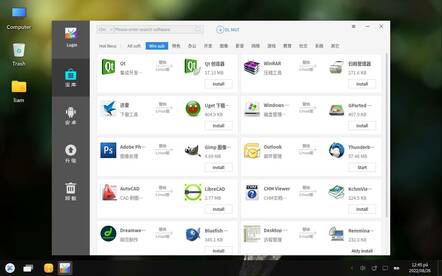
The Ubuntu Kylin Software Center isn't very helpful if you don't speak Chinese, but we do like the list of Windows tool replacements
The app store features a section devoted to mobile apps. If you try to install any of these, it prompts to install KMRE, an Android runtime environment. As Google is blocked by the Great Firewall of China, we found no familiar names in this section. We picked a random mapping app, but sadly it wouldn't launch.
Kylin Pro has a few additional apps, such as the "Kmre Apk Installer" [sic], a handy "Toolkit" app to gather system info for tech support, and a quite comprehensive manual. There is a status bar icon for the FCITX input method, which lets you compose Chinese characters using a QWERTY keyboard. This also provides an on-screen soft keyboard. If you don't need that, you can disable and exit the applet.
The taskbar has several widgets preinstalled. There's a weather app, but sadly it only offers a list of cities in China, and searching didn't work. There's a magnifying glass that offers both computer and web searches, but the only available search engines are Baidu, Sougou and 360.

The choices of search engine in Ubuntu Kylin Pro are limited to just three search engines in the People's Republic
Interestingly there are two update notifiers in the taskbar by default. One is for general OS updates, and the other is for Ubuntu's kernel Livepatch service. As that's a paid-for optional extra, unless you connect your copy to a paid Ubuntu Advantage account, it won't work.
Apart from these extras, the rest of the OS is much like any other Ubuntu variant. The chances are that the Chinese software store won't be much use to you, but it's easy to just install the normal Ubuntu Software Center instead:
sudo apt install gnome-software
We experimentally uninstalled FCITX and the Kylin Software Center with no visible ill-effects.
We saw a few niggles in testing. On our Thinkpad T420 test machine, Kylin Pro keeps setting the backlight to dim and then completely off, meaning that the screen goes dark. We had to manually turn the brightness back up with the function keys.
Interesting, in the Settings | About screen, there's no name in the "version" field, and the copyright notice is to KylinSoft with no mention of Ubuntu at all.
Ubuntu Kylin – international edition
The other version of Ubuntu Kylin, from Ubuntu's download page, is rather harder to find: we just happened to stumble across it when looking for the version 22.04.1 ISOs of all the remixes.
This flavor of Ubuntu Kylin is far more like a conventional remix. If you don't speak or read Chinese, this is the one you want. It boots in English, it has the standard Ubiquity installer that all the flavors except Lubuntu use, and it offers Ubuntu's usual wide range of internationalizations. For full disclosure, we didn't test it in anything except English, but from the screenshot you may notice that the date is displayed in Czech – like other remixes, it found a Prague IP address and did this automatically.
That also means that the installer (and the login screen) ask for and use full names, rather than just usernames, and in testing it happily accepted a seven-character password. The installer was less particular about partitioning, too, but in our BIOS-based VM, it created a GRUB BIOS-boot and ESP partitions.
When installed, you get LibreOffice instead of the freeware-but-closed-source WPS Office. Aside from that, though, the OS is still pervasively Chinese. You still get the Chinese-language Kylin Software Center, and as you can see in the screenshot, it's complete with an Android icon in the toolbar on the left. However, if you click that, it merely displays an error: "Missing environment: unable to install APP". The KMRE runtime isn't in the repos, either, so no Android support for you. You also get the Chinese input method, the double update icons and so on.
However, if you right-click the update notifier – either of them – and pick "Preferences" or "Settings", the normal Ubuntu "Software & Drivers" tool opens. You can go to the "Ubuntu Software" tab, pick "Download from" and let it select the best mirror server, and it will happily use it.
Interestingly, inside the Settings app, the OS doesn't describe itself as Ubuntu anything. It calls itself "Kylin Linux Desktop V10 (SP1)".
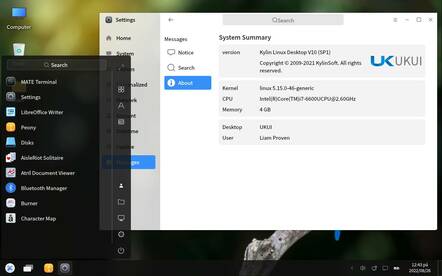
Ubuntu Kylin describes itself as Kylin Linux V10. Note the different start menu layout and the default dark theme
Rounding up
Ubuntu Kylin is somewhat quicker and easier to install, and to update and modify, than Ubuntu Kylin Pro. You can install WPS Office 2019 easily if you want (and in turn, Ubuntu Kylin Pro is easier to install than openKylin, as well as being much more current.)
However, all of them are perfectly usable in English once you've got them installed. It's interesting to do so, and they are very much worth a look.
The desktop is very similar across both Ubuntu Kylin editions. The Pro version has some extra apps and tools which are omitted from the international edition. Several, though, are not much use outside China, such as the Weather applet. The international edition has a dark theme by default, and some useful buttons down the right side of the start menu, while the Pro edition just has a bright red power symbol.
UKUI is an attractive desktop. It captures some of the best elements of Windows 7, such as tasteful use of transparency, along with some of those of Windows 10, such as the unified notifications sidebar and full-screen app-launcher, and even some of those of Windows 11, such as centred taskbar icons. It's moderately customizable: the panel can be on any screen edge, in any of three sizes, it comes with dark mode and a variety of icon themes, and so on. It's nowhere near as customizable as KDE or Xfce, but that hasn't hurt GNOME or Pantheon any.
It's a shame that the more standard international edition is missing some of the features that Chinese users get in Kylin Pro. It would be good to see global search and weather apps, and an international software store, alongside LibreOffice. This desktop has real potential: frankly, we reckon that it looks and works better than some more mainstream desktops such as Cinnamon, Pantheon, or GNOME itself. It's not perfect – for instance, we prefer menu bars to UKUI's half-hidden "hamburger menu", but many desktops favour this style now, including recent versions of KDE.
We asked Canonical how official Ubuntu Kylin was as a project. It replied:
Ubuntu Kylin is a project which we recognize as an official flavor. The project began with its first release (13.04) in 2013, as a collaboration between Canonical, the Ministry of Industry and Information Technology Software and Integrated Circuit Public Service Platform and the National University of Defence Technology, to create a flavor of Ubuntu optimized for usage in Chinese.
Canonical isn't now involved in the maintenance and development of Ubuntu Kylin – from our perspective it's a community project, like Kubuntu or Xubuntu.
The other Kylin OSes are not flavors of Ubuntu, or related to Canonical.
Well, we have news for the company: they certainly look like versions of Ubuntu to us.
Neither Canonical nor The Register have any official download numbers, and Ubuntu Kylin is only number 115 or so on Distrowatch, but we suspect it might be substantially more popular than that suggests. There are about half a billion households in China, and over half have a computer.
Western estimates of Ubuntu users are about 40 million. Deepin seems to be the leader, but the various variants of Kylin are in second place. We have a suspicion that there may be many times more users of the various forms of Kylin than all the other Ubuntu variants put together.
All the leading Western distros tend to focus on GNOME, which is a very controversial desktop. After 38 releases of GNOME 3 and three so far of GNOME 4.x, it's still arguing about themes, and avoiding Unity and GNOME has driven Linux Mint considerable popularity.
It seems to us that there's a big, although possibly controversial, opportunity for Ubuntu here: to bring Chinese UI improvements to the Western mainstream. ®
Bootnote: What is a Kylin anyway?
The kylin (kee-LIN) or qilin (chee-LIN) is a mythical creature from Asian mythology, resembling a scaly dragon with horns or antlers, a deer-shaped body, cloven hooves, and the tail of an ox. It's often called a Chinese unicorn, but most representations seem to have two branching horns.
It's gilin in Korean and kirin in Japanese – so yes, the beer is named after it, too.
